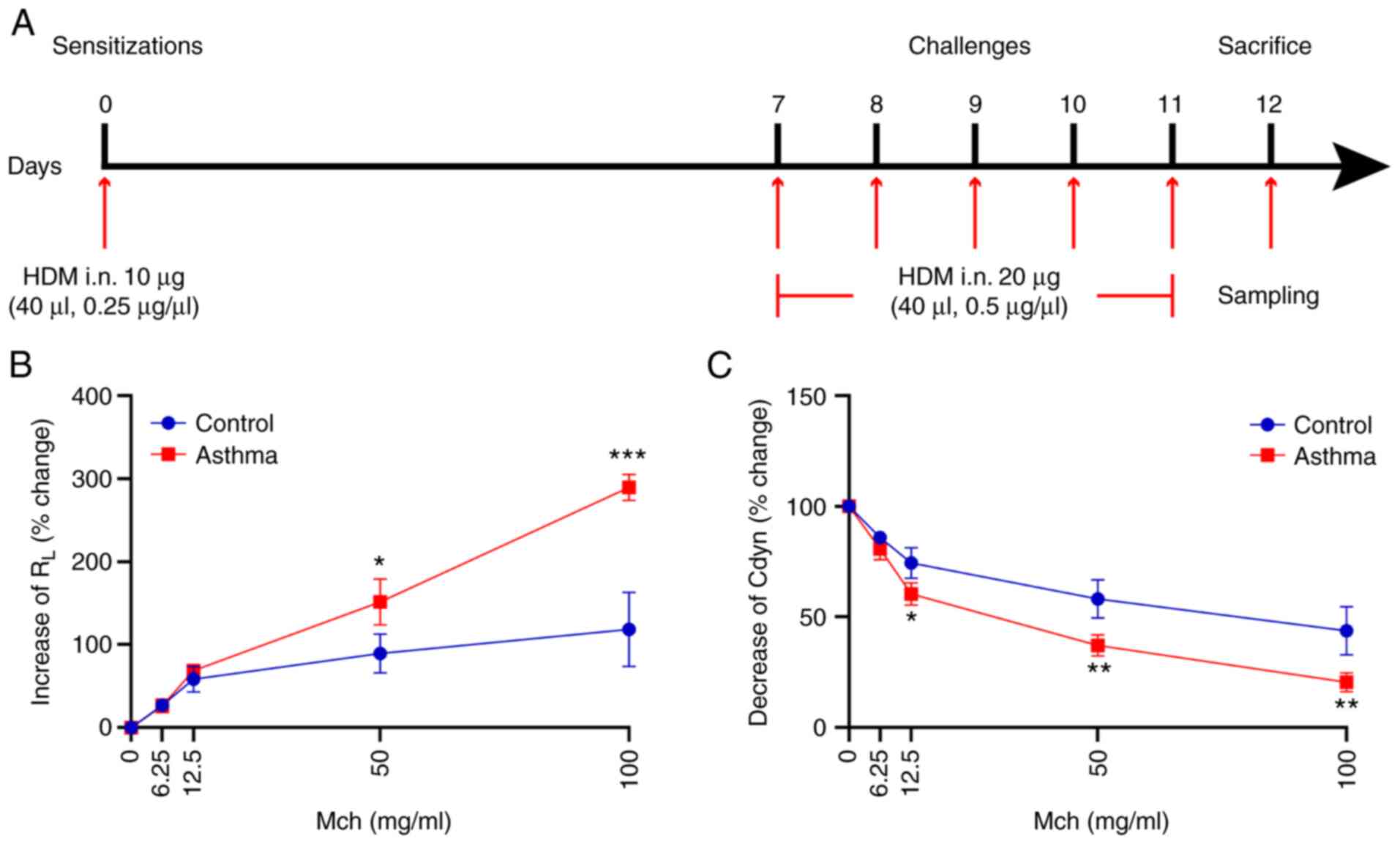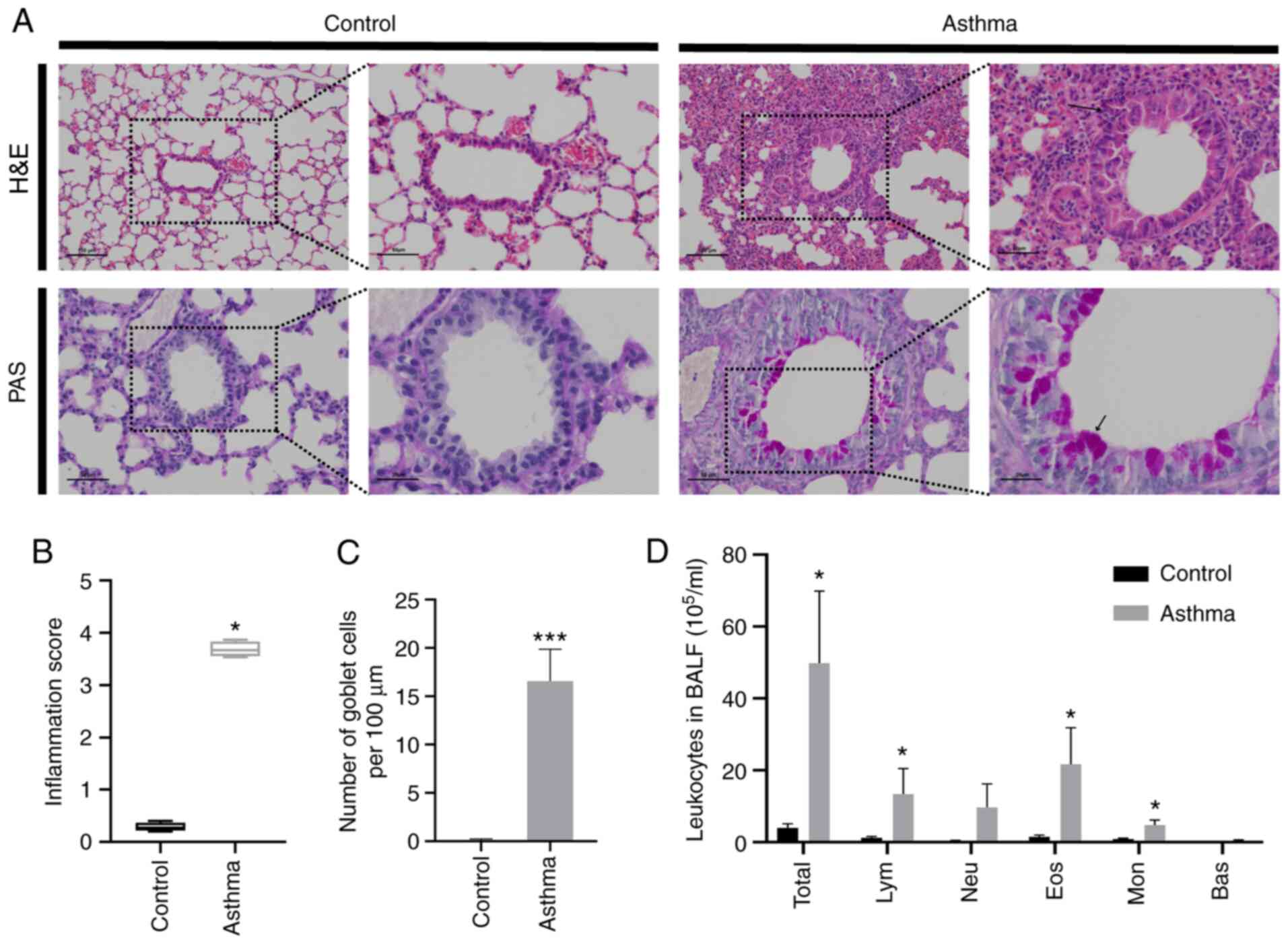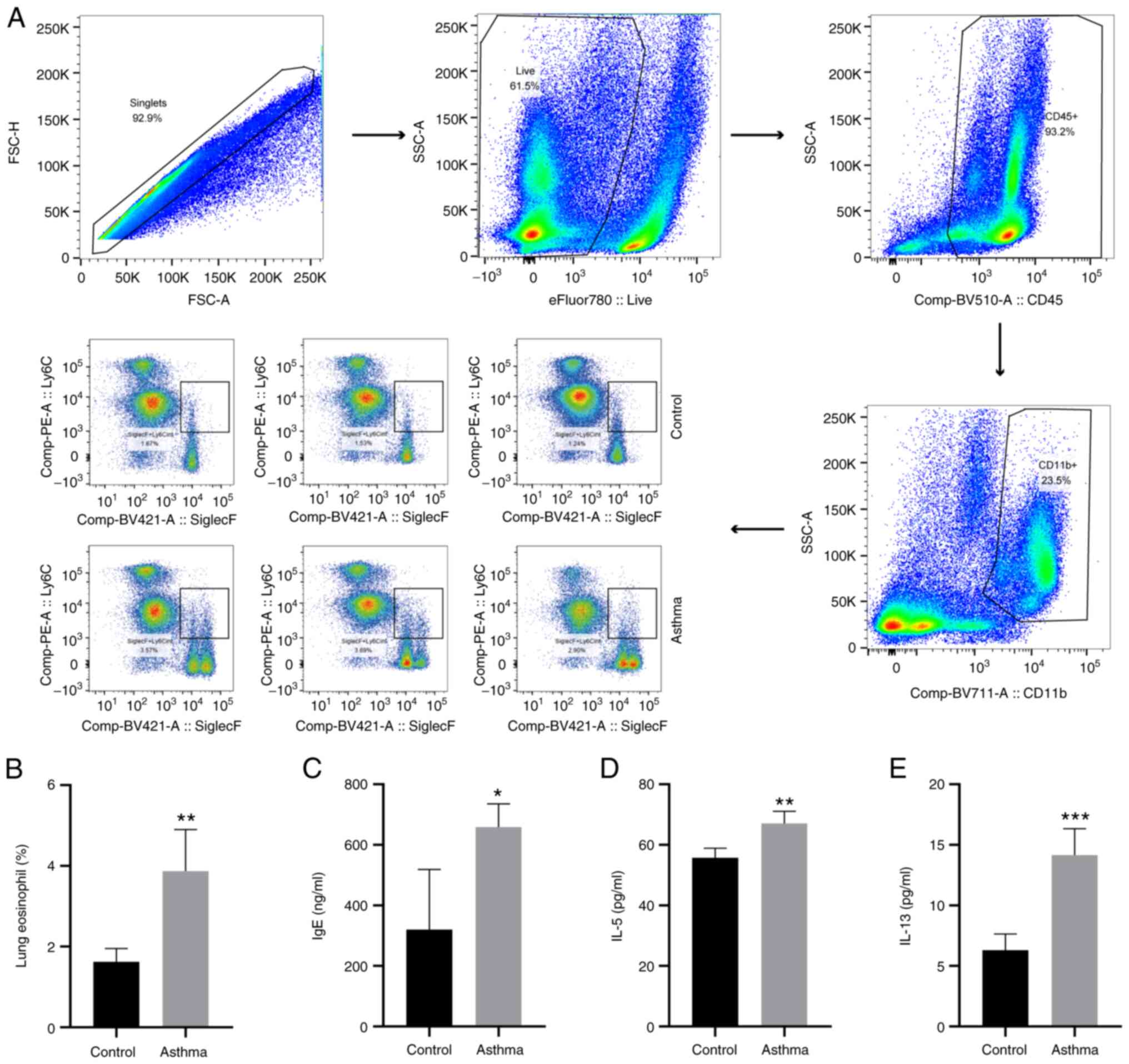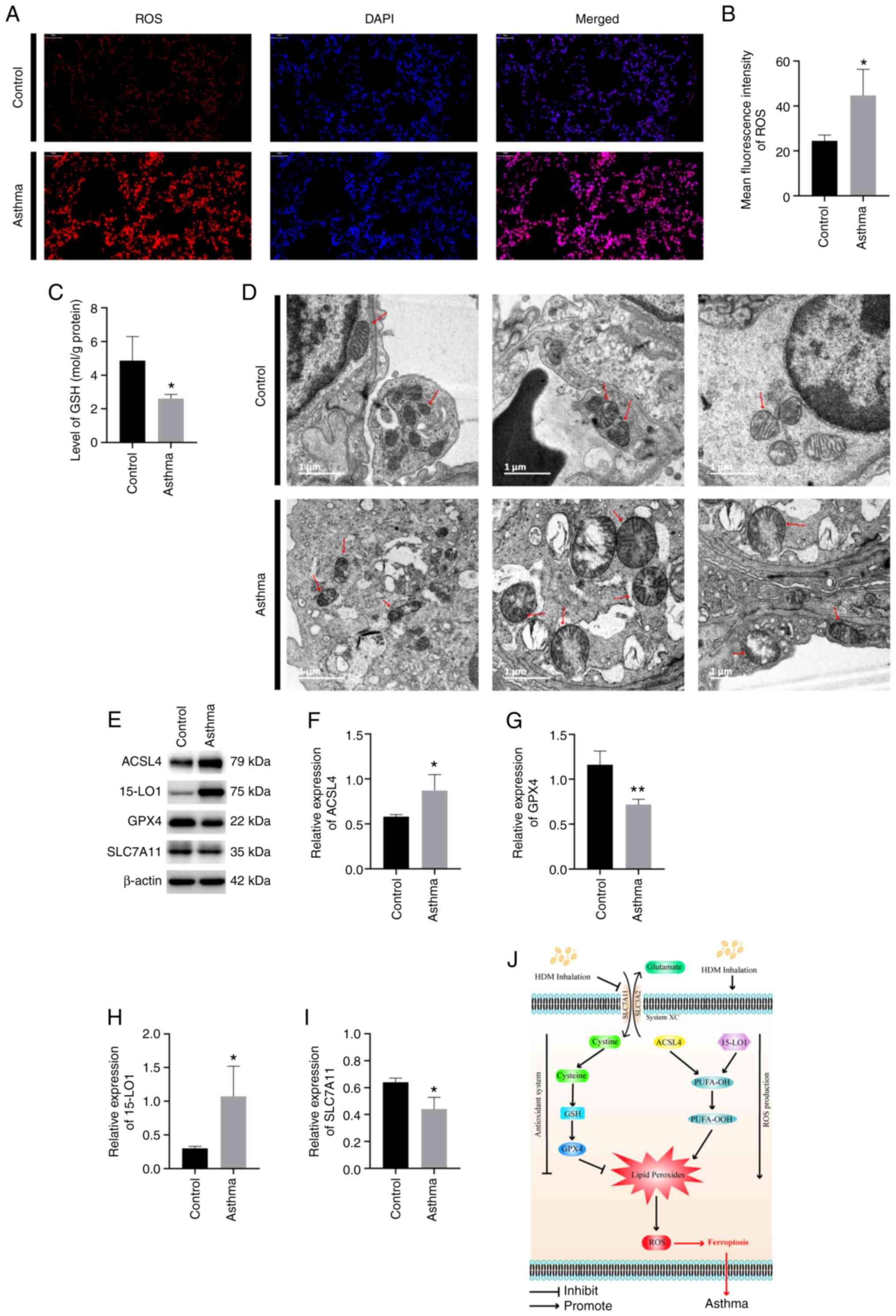|
1
|
Caraballo L, Zakzuk J, Lee BW, Acevedo N,
Soh JY, Sánchez-Borges M, Hossny E, García E, Rosario N, Ansotegui
I, et al: Particularities of allergy in the tropics. World Allergy
Organ J. 9(20)2016.PubMed/NCBI View Article : Google Scholar
|
|
2
|
Abou-Hamdan M, Gharib B, Bajenoff M, Julia
V and de Reggi M: Pantethine down-regulates leukocyte recruitment
and inflammatory parameters in a mouse model of allergic airway
inflammation. Med Sci Monit Basic Res. 23:368–372. 2017.PubMed/NCBI View Article : Google Scholar
|
|
3
|
Rogliani P, Calzetta L, Matera MG, Laitano
R, Ritondo BL, Hanania NA and Cazzola M: Severe asthma and
biological therapy: When, which, and for whom? Pulm Ther. 6:47–66.
2020.PubMed/NCBI View Article : Google Scholar
|
|
4
|
Calzetta L, Matera MG, Coppola A and
Rogliani P: Prospects for severe asthma treatment. Curr Opin
Pharmacol. 56:52–60. 2020.PubMed/NCBI View Article : Google Scholar
|
|
5
|
Reddel HK, Bateman ED, Becker A, Boulet
LP, Cruz AA, Drazen JM, Haahtela T, Hurd SS, Inoue H, de Jongste
JC, et al: A summary of the new GINA strategy: A roadmap to asthma
control. Eur Respir J. 46:622–639. 2015.PubMed/NCBI View Article : Google Scholar
|
|
6
|
Sulaiman I, Greene G, MacHale E, Seheult
J, Mokoka M, D'Arcy S, Taylor T, Murphy DM, Hunt E, Lane SJ, et al:
A randomised clinical trial of feedback on inhaler adherence and
technique in patients with severe uncontrolled asthma. Eur Respir
J. 51(1701126)2018.PubMed/NCBI View Article : Google Scholar
|
|
7
|
Caraballo L: Mite allergens. Expert Rev
Clin Immunol. 13:297–299. 2017.PubMed/NCBI View Article : Google Scholar
|
|
8
|
Yang L and Zhu R: Immunotherapy of house
dust mite allergy. Hum Vaccin Immunother. 13:2390–2396.
2017.PubMed/NCBI View Article : Google Scholar
|
|
9
|
Custovic A, Green R, Smith A, Chapman MD
and Woodcock A: New mattresses: How fast do they become a
significant source of exposure to house dust mite allergens? Clin
Exp Allergy. 26:1243–1245. 1996.PubMed/NCBI
|
|
10
|
Fernández-Caldas E, Puerta L and Caraballo
L: Mites and allergy. Chem Immunol Allergy. 100:234–242.
2014.PubMed/NCBI View Article : Google Scholar
|
|
11
|
Li L, Qian J, Zhou Y and Cui Y: Domestic
mite-induced allergy: Causes, diagnosis, and future prospects. Int
J Immunopathol Pharmacol. 32(2058738418804095)2018.PubMed/NCBI View Article : Google Scholar
|
|
12
|
Jacquet A: Interactions of airway
epithelium with protease allergens in the allergic response. Clin
Exp Allergy. 41:305–311. 2011.PubMed/NCBI View Article : Google Scholar
|
|
13
|
Dolma S, Lessnick SL, Hahn WC and
Stockwell BR: Identification of genotype-selective antitumor agents
using synthetic lethal chemical screening in engineered human tumor
cells. Cancer Cell. 3:285–296. 2003.PubMed/NCBI View Article : Google Scholar
|
|
14
|
Dixon SJ, Lemberg KM, Lamprecht MR, Skouta
R, Zaitsev EM, Gleason CE, Patel DN, Bauer AJ, Cantley AM, Yang WS,
et al: Ferroptosis: An iron-dependent form of nonapoptotic cell
death. Cell. 149:1060–1072. 2012.PubMed/NCBI View Article : Google Scholar
|
|
15
|
Gao M, Yi J, Zhu J, Minikes AM, Monian P,
Thompson CB and Jiang X: Role of mitochondria in ferroptosis. Mol
Cell. 73:354–363.e3. 2019.PubMed/NCBI View Article : Google Scholar
|
|
16
|
Tang D, Kang R, Berghe TV, Vandenabeele P
and Kroemer G: The molecular machinery of regulated cell death.
Cell Res. 29:347–364. 2019.PubMed/NCBI View Article : Google Scholar
|
|
17
|
Friedmann Angeli JP, Schneider M, Proneth
B, Tyurina YY, Tyurin VA, Hammond VJ, Herbach N, Aichler M, Walch
A, Eggenhofer E, et al: Inactivation of the ferroptosis regulator
Gpx4 triggers acute renal failure in mice. Nat Cell Biol.
16:1180–1191. 2014.PubMed/NCBI View Article : Google Scholar
|
|
18
|
Wu X, Li Y, Zhang S and Zhou X:
Ferroptosis as a novel therapeutic target for cardiovascular
disease. Theranostics. 11:3052–3059. 2021.PubMed/NCBI View Article : Google Scholar
|
|
19
|
Ghiamati Yazdi F, Zakeri A, van Ark I,
Leusink-Muis T, Braber S, Soleimanian-Zad S and Folkerts G: Crude
turmeric extract improves the suppressive effects of lactobacillus
rhamnosus GG on allergic inflammation in a murine model of house
dust mite-induced asthma. Front Immunol. 11(1092)2020.PubMed/NCBI View Article : Google Scholar
|
|
20
|
Tibbitt CA, Stark JM, Martens L, Ma J,
Mold JE, Deswarte K, Oliynyk G, Feng X, Lambrecht BN, De Bleser P,
et al: Single-cell RNA sequencing of the T helper cell response to
house dust mites defines a distinct gene expression signature in
airway Th2 cells. Immunity. 51:169–184.e5. 2019.PubMed/NCBI View Article : Google Scholar
|
|
21
|
Wei Y, Dong M, Zhang H, Lv Y, Liu J, Wei
K, Luo Q, Sun J, Liu F, Xu F and Dong J: Acupuncture attenuated
inflammation and inhibited Th17 and treg activity in experimental
asthma. Evid Based Complement Alternat Med.
2015(340126)2015.PubMed/NCBI View Article : Google Scholar
|
|
22
|
Wang S, Wuniqiemu T, Tang W, Teng F, Bian
Q, Yi L, Qin J, Zhu X, Wei Y and Dong J: Luteolin inhibits
autophagy in allergic asthma by activating PI3K/Akt/mTOR signaling
and inhibiting Beclin-1-PI3KC3 complex. Int Immunopharmacol.
94(107460)2021.PubMed/NCBI View Article : Google Scholar
|
|
23
|
Myou S, Leff AR, Myo S, Boetticher E, Tong
J, Meliton AY, Liu J, Munoz NM and Zhu X: Blockade of inflammation
and airway hyperresponsiveness in immune-sensitized mice by
dominant-negative phosphoinositide 3-kinase-TAT. J Exp Med.
198:1573–1582. 2003.PubMed/NCBI View Article : Google Scholar
|
|
24
|
Gavino AC, Nahmod K, Bharadwaj U,
Makedonas G and Tweardy DJ: STAT3 inhibition prevents lung
inflammation, remodeling, and accumulation of Th2 and Th17 cells in
a murine asthma model. Allergy. 71:1684–1692. 2016.PubMed/NCBI View Article : Google Scholar
|
|
25
|
Honda K, Arima M, Cheng G, Taki S, Hirata
H, Eda F, Fukushima F, Yamaguchi B, Hatano M, Tokuhisa T and Fukuda
T: Prostaglandin D2 reinforces Th2 type inflammatory responses of
airways to low-dose antigen through bronchial expression of
macrophage-derived chemokine. J Exp Med. 198:533–543.
2003.PubMed/NCBI View Article : Google Scholar
|
|
26
|
Yi S, Zhai J, Niu R, Zhu G, Wang M, Liu J,
Huang H, Wang Y, Jing X, Kang L, et al: Eosinophil recruitment is
dynamically regulated by interplay among lung dendritic cell
subsets after allergen challenge. Nat Commun.
9(3879)2018.PubMed/NCBI View Article : Google Scholar
|
|
27
|
Fransén-Pettersson N, Duarte N, Nilsson J,
Lundholm M, Mayans S, Larefalk Å, Hannibal TD, Hansen L,
Schmidt-Christensen A, Ivars F, et al: A new mouse model that
spontaneously develops chronic liver inflammation and fibrosis.
PLoS One. 11(e0159850)2016.PubMed/NCBI View Article : Google Scholar
|
|
28
|
Cheng D, Xue Z, Yi L, Shi H, Zhang K, Huo
X, Bonser LR, Zhao J, Xu Y, Erle DJ and Zhen G: Epithelial
interleukin-25 is a key mediator in Th2-high,
corticosteroid-responsive asthma. Am J Respir Crit Care Med.
190:639–648. 2014.PubMed/NCBI View Article : Google Scholar
|
|
29
|
Doll S, Proneth B, Tyurina YY, Panzilius
E, Kobayashi S, Ingold I, Irmler M, Beckers J, Aichler M, Walch A,
et al: ACSL4 dictates ferroptosis sensitivity by shaping cellular
lipid composition. Nat Chem Biol. 13:91–98. 2017.PubMed/NCBI View Article : Google Scholar
|
|
30
|
Telorack M, Meyer M, Ingold I, Conrad M,
Bloch W and Werner S: A glutathione-Nrf2-thioredoxin cross-talk
ensures keratinocyte survival and efficient wound repair. PLoS
Genet. 12(e1005800)2016.PubMed/NCBI View Article : Google Scholar
|
|
31
|
Ish P, Malhotra N and Gupta N: GINA 2020:
What's new and why? J Asthma. 58:1273–1277. 2021.PubMed/NCBI View Article : Google Scholar
|
|
32
|
Hogan AD and Bernstein JA: GINA updated
2019: Landmark changes recommended for asthma management. Ann
Allergy Asthma Immunol. 124:311–313. 2020.PubMed/NCBI View Article : Google Scholar
|
|
33
|
Wenzel SE: Asthma phenotypes: The
evolution from clinical to molecular approaches. Nat Med.
18:716–725. 2012.PubMed/NCBI View Article : Google Scholar
|
|
34
|
Agache I and Akdis CA: Precision medicine
and phenotypes, endotypes, genotypes, regiotypes, and theratypes of
allergic diseases. J Clin Invest. 129:1493–1503. 2019.PubMed/NCBI View Article : Google Scholar
|
|
35
|
Ito R, Maruoka S, Soda K, Katano I, Kawai
K, Yagoto M, Hanazawa A, Takahashi T, Ogura T, Goto M, et al: A
humanized mouse model to study asthmatic airway inflammation via
the human IL-33/IL-13 axis. JCI Insight. 3(e121580)2018.PubMed/NCBI View Article : Google Scholar
|
|
36
|
Jäger A and Kuchroo VK: Effector and
regulatory T-cell subsets in autoimmunity and tissue inflammation.
Scand J Immunol. 72:173–184. 2010.PubMed/NCBI View Article : Google Scholar
|
|
37
|
Shang XZ, Ma KY, Radewonuk J, Li J, Song
XY, Griswold DE, Emmell E and Li L: IgE isotype switch and IgE
production are enhanced in IL-21-deficient but not
IFN-gamma-deficient mice in a Th2-biased response. Cell Immunol.
241:66–74. 2006.PubMed/NCBI View Article : Google Scholar
|
|
38
|
Gough L, Sewell HF and Shakib F: The
proteolytic activity of the major dust mite allergen Der p 1
enhances the IgE antibody response to a bystander antigen. Clin Exp
Allergy. 31:1594–1598. 2001.PubMed/NCBI View Article : Google Scholar
|
|
39
|
Qiu S, Fan X, Yang Y, Dong P, Zhou W, Xu
Y, Zhou Y, Guo F, Zheng Y and Yang JQ: Schistosoma japonicum
infection downregulates house dust mite-induced allergic airway
inflammation in mice. PLoS One. 12(e0179565)2017.PubMed/NCBI View Article : Google Scholar
|
|
40
|
Lambrecht BN, Hammad H and Fahy JV: The
cytokines of asthma. Immunity. 50:975–991. 2019.PubMed/NCBI View Article : Google Scholar
|
|
41
|
Bush A: Cytokines and chemokines as
biomarkers of future asthma. Front Pediatr. 7(72)2019.PubMed/NCBI View Article : Google Scholar
|
|
42
|
Zou Y and Schreiber SL: Progress in
understanding ferroptosis and challenges in its targeting for
therapeutic benefit. Cell Chem Biol. 27:463–471. 2020.PubMed/NCBI View Article : Google Scholar
|
|
43
|
Gao M and Jiang X: To eat or not to
eat-the metabolic flavor of ferroptosis. Curr Opin Cell Biol.
51:58–64. 2018.PubMed/NCBI View Article : Google Scholar
|
|
44
|
Krainz T, Gaschler MM, Lim C, Sacher JR,
Stockwell BR and Wipf P: A mitochondrial-targeted nitroxide is a
potent inhibitor of ferroptosis. ACS Cent Sci. 2:653–659.
2016.PubMed/NCBI View Article : Google Scholar
|
|
45
|
Konstorum A, Tesfay L, Paul BT, Torti FM,
Laubenbacher RC and Torti SV: Systems biology of ferroptosis: A
modeling approach. J Theor Biol. 493(110222)2020.PubMed/NCBI View Article : Google Scholar
|
|
46
|
Lu SC: Regulation of glutathione
synthesis. Mol Aspects Med. 30:42–59. 2009.PubMed/NCBI View Article : Google Scholar
|
|
47
|
Dixon SJ and Stockwell BR: The role of
iron and reactive oxygen species in cell death. Nat Chem Biol.
10:9–17. 2014.PubMed/NCBI View Article : Google Scholar
|
|
48
|
Ingold I, Berndt C, Schmitt S, Doll S,
Poschmann G, Buday K, Roveri A, Peng X, Porto Freitas F, Seibt T,
et al: Selenium utilization by GPX4 is required to prevent
hydroperoxide-induced ferroptosis. Cell. 172:409–422.e21.
2018.PubMed/NCBI View Article : Google Scholar
|
|
49
|
Xu Y, Li X, Cheng Y, Yang M and Wang R:
Inhibition of ACSL4 attenuates ferroptotic damage after pulmonary
ischemia-reperfusion. FASEB J. 34:16262–16275. 2020.PubMed/NCBI View Article : Google Scholar
|
|
50
|
Zhou Y, Liao J, Mei Z, Liu X and Ge J:
Insight into crosstalk between ferroptosis and necroptosis: Novel
therapeutics in ischemic stroke. Oxid Med Cell Longev.
2021(9991001)2021.PubMed/NCBI View Article : Google Scholar
|
|
51
|
Nicolaou A, Mauro C, Urquhart P and
Marelli-Berg F: Polyunsaturated fatty acid-derived lipid mediators
and T cell function. Front Immunol. 5(75)2014.PubMed/NCBI View Article : Google Scholar
|
|
52
|
Wenzel SE, Tyurina YY, Zhao J, St Croix
CM, Dar HH, Mao G, Tyurin VA, Anthonymuthu TS, Kapralov AA,
Amoscato AA, et al: PEBP1 wardens ferroptosis by enabling
lipoxygenase generation of lipid death signals. Cell.
171:628–641.e26. 2017.PubMed/NCBI View Article : Google Scholar
|
|
53
|
Zhao J, O'Donnell VB, Balzar S, St Croix
CM, Trudeau JB and Wenzel SE: 15-Lipoxygenase 1 interacts with
phosphatidylethanolamine-binding protein to regulate MAPK signaling
in human airway epithelial cells. Proc Natl Acad Sci USA.
108:14246–14251. 2011.PubMed/NCBI View Article : Google Scholar
|
|
54
|
Sun X, Ou Z, Chen R, Niu X, Chen D, Kang R
and Tang D: Activation of the p62-Keap1-NRF2 pathway protects
against ferroptosis in hepatocellular carcinoma cells. Hepatology.
63:173–184. 2016.PubMed/NCBI View Article : Google Scholar
|
|
55
|
Schrier MS, Trivedi MS and Deth RC:
Redox-related epigenetic mechanisms in glioblastoma: Nuclear factor
(erythroid-derived 2)-like 2, cobalamin, and dopamine receptor
subtype 4. Front Oncol. 7(46)2017.PubMed/NCBI View Article : Google Scholar
|
|
56
|
Xu X, Zhang X, Wei C, Zheng D, Lu X, Yang
Y, Luo A, Zhang K, Duan X and Wang Y: Targeting SLC7A11
specifically suppresses the progression of colorectal cancer stem
cells via inducing ferroptosis. Eur J Pharm Sci.
152(105450)2020.PubMed/NCBI View Article : Google Scholar
|
|
57
|
Zhang Y, Zhuang L and Gan B: BAP1
suppresses tumor development by inducing ferroptosis upon SLC7A11
repression. Mol Cell Oncol. 6(1536845)2018.PubMed/NCBI View Article : Google Scholar
|


















